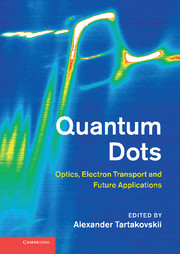Book contents
- Frontmatter
- Contents
- List of contributors
- Preface
- Part I Nanostructure design and structural properties of epitaxially grown quantum dots and nanowires
- 1 Growth of III–V semiconductor quantum dots
- 2 Single semiconductor quantum dots in nanowires: growth, optics, and devices
- 3 Atomic-scale analysis of self-assembled quantum dots by cross-sectional scanning, tunneling microscopy, and atom probe tomography
- Part II Manipulation of individual quantum states in quantum dots using optical techniques
- Part III Optical properties of quantum dots in photonic cavities and plasmon-coupled dots
- Part IV Quantum dot nano-laboratory: magnetic ions and nuclear spins in a dot
- Part V Electron transport in quantum dots fabricated by lithographic techniques from III–V semiconductors and graphene
- Part VI Single dots for future telecommunications applications
- Index
- References
1 - Growth of III–V semiconductor quantum dots
from Part I - Nanostructure design and structural properties of epitaxially grown quantum dots and nanowires
Published online by Cambridge University Press: 05 August 2012
- Frontmatter
- Contents
- List of contributors
- Preface
- Part I Nanostructure design and structural properties of epitaxially grown quantum dots and nanowires
- 1 Growth of III–V semiconductor quantum dots
- 2 Single semiconductor quantum dots in nanowires: growth, optics, and devices
- 3 Atomic-scale analysis of self-assembled quantum dots by cross-sectional scanning, tunneling microscopy, and atom probe tomography
- Part II Manipulation of individual quantum states in quantum dots using optical techniques
- Part III Optical properties of quantum dots in photonic cavities and plasmon-coupled dots
- Part IV Quantum dot nano-laboratory: magnetic ions and nuclear spins in a dot
- Part V Electron transport in quantum dots fabricated by lithographic techniques from III–V semiconductors and graphene
- Part VI Single dots for future telecommunications applications
- Index
- References
Summary
Introduction
The advanced growth of semiconductor quantum dots (QDs) with high optical quality is one key to realizing novel devices in various research disciplines related to modern semiconductor technologies. Despite recent progress in the top-down lithographic fabrication of single semiconductor QD-like emitters [43], bottom-up fabrication methods are commonly applied for the realization of high quality light emitting QDs [7]. The exploitation of high-density QD arrays as an active material in laser diodes [17] and vertical cavity surface emitting lasers (VCSEL) resulted in a new class of devices featuring lower lasing thresholds and improved device performance (such as temperature stability) in comparison to devices with higher dimensional gain [2, 3].
Spintronics and quantum information processing are intensively studied fields in order to provide complementary or entirely novel routes to a future information technology [12, 5]. Single self-assembled quantum dots (QDs) grown in low-density arrays are promising candidates for realizing functional building blocks in these research fields as they allow to confine single charge carriers or spin carriers while providing a solid-state platform capable of electrical injection or manipulation. Extensive research has resulted in the realization of various devices relying on few or single QDs, for instance quantum light emitters such as single photon sources [23, 36], sources of pairs of entangled photons [1, 45], and fewto single-QD lasers [38]. Moreover, many milestone experiments have been performed with In(Ga)As QDs grown on GaAs, for instance the observation of the Purcell effect [10] or reaching the strong QD exciton–photon coupling regime [26], demonstration of the indistinguishability of photons emitted by a QD [29], or complete control of a single spin by ultrafast optical pulses [25].
- Type
- Chapter
- Information
- Quantum DotsOptics, Electron Transport and Future Applications, pp. 3 - 20Publisher: Cambridge University PressPrint publication year: 2012



